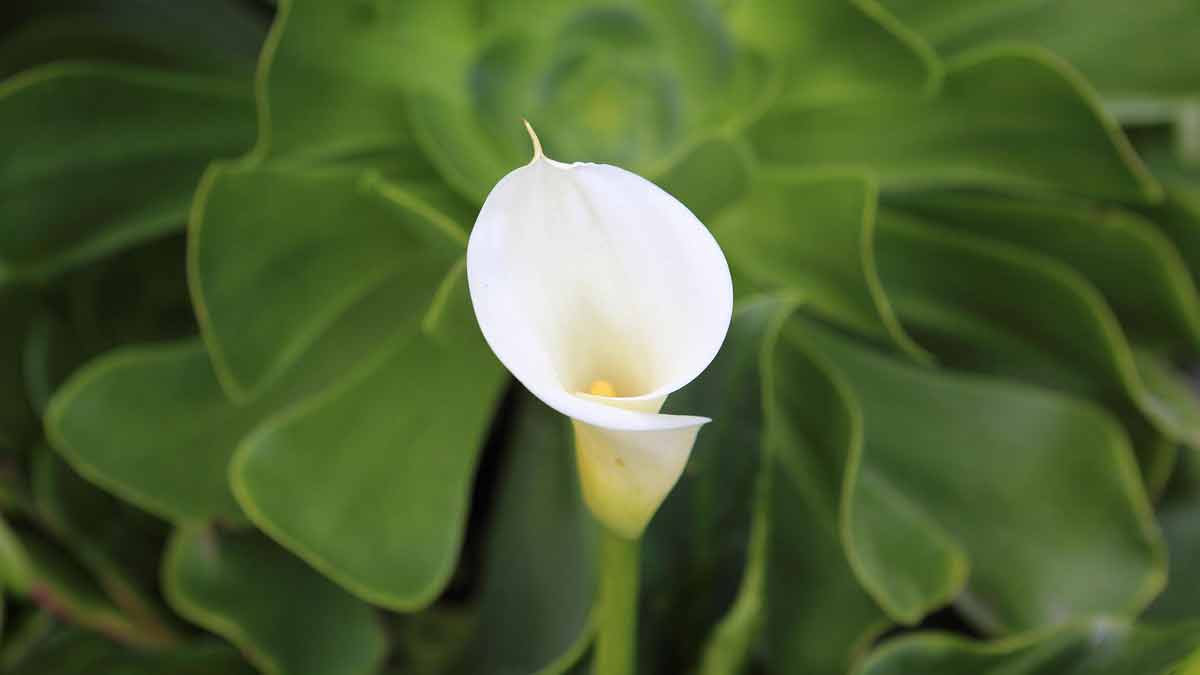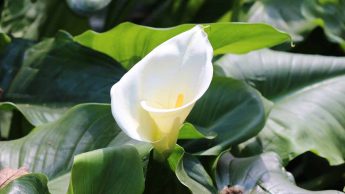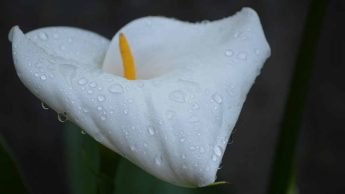Calla lily leaves may curl due to factors like underwatering, overwatering, pests, light or heat issues, nutrient deficiency, compacted soil, overfertilization, transplant shock, or root damage. To fix, adjust watering, lighting, and nutrients, address pests, and avoid overfertilization. Transplant carefully and watch for root damage.
Calla lily plants (Zantedeschia spp.) are grown for their large, showy flowers bloom in various colors.
Though typically hardy, these rhizomatous perennials can be susceptible to various problems, including curling leaves.
If your calla lily leaves are curling, it could be due to several reasons.
Here are 10 possible explanations for why your calla lily leaves are curling, along with solutions for each issue.
Why Are My Calla Lily Leaves Curling and How Can You Fix It?
There are a few reasons your calla lily leaves could be curling. And thankfully, most of them have easy solutions.
Here are the 10 most common reasons for curling calla lily leaves and what you can do about them.
1. Underwatering
If your calla lily isn’t getting enough water, its leaves will start to wilt and curl.
This is because plants can’t transport nutrients and moisture from the roots to the leaves when they don’t have enough water.
Underwatering can happen for a few reasons:
- You’re not watering your calla lily regularly. Calla lilies must be watered about once a week or when the soil feels dry.
- You’re not using enough water. When you do water your plant, make sure to give it a good soaking so the water can reach the roots.
- The pot doesn’t have drainage holes. If water can’t drain out of the pot, it will start to accumulate and drown the plant.
How To Tell If You’re Underwatering Your Calla Lily
There are a few telltale signs that you’re not watering your calla lily enough.
- The leaves will start to wilt and droop. If you touch the leaves, they’ll feel papery and dry.
- The flower buds will start to turn brown and drop off before they have a chance to bloom.
- The stem may start to shrink or wrinkle.
How To Fix An Underwatered Calla Lily
If you think your plant is underwatered, you can do a few things to help it recover.
- Water your plant deeply and thoroughly. Be sure to saturate the soil around the roots.
- If the soil is dry several inches down, you may need to water more frequently.
- Increase the frequency of watering until the leaves start to recover.
- Don’t let the plant sit in water. Be sure to drain any excess water from the pot or tray.
2. Overwatering
Though underwatering is a more common problem, overwatering can cause calla lily leaves to curl.
When Calla Lily plants are overwatered, the roots start to rot, which prevents the plant from taking up water and nutrients.
This can cause the leaves to wilt and eventually die.
Overwatering can happen for a few reasons:
- You’re watering too often. Calla lilies only need to be watered about once a week or when the soil feels dry to the touch.
- You’re using too much water. When you do water your plant, make sure to give it a good soaking so the water can reach the roots.
- The pot doesn’t have drainage holes. If water can’t drain out of the pot, it will start to accumulate and drown the plant.
How To Tell If You’re Overwatering Your Calla Lily
There are a few telltale signs that you’re overwatering your calla lily.
- The leaves will start to yellow and curl. If the leaves are only slightly yellow and still mostly green, you may be able to save the plant by watering it less often.
- The stem will start to rot. This is a sign that the roots are already starting to rot, and the plant will likely die if you don’t take action.
- You may see mold or mildew on the plant. This is another sign of too much moisture and can harm the plant and you if inhaled.
- The plant will start to wilt. This is a sign that the roots are not getting enough oxygen, and the plant is dying.
How To Fix An Overwatered Calla Lily
If you think your plant is overwatered, you can do a few things to help it recover.
- Stop watering the plant until the soil has had a chance to dry out completely. This may take a week or more.
- If the roots start to rot, you may need to repot the plant in fresh, dry soil.
- If the leaves are only slightly yellow, you may be able to save the plant by watering it less often.
- Ensure that the pot has drainage holes so that water can drain out.
3. Pests
Pests can also cause calla lily leaves to curl. Aphids, spider mites, and whiteflies are all common pests that can attack calla lilies.
These pests suck the sap out of the leaves, which weakens the plant and can cause the leaves to curl.
Pests can also spread diseases, which can further damage the plant.
How To Tell If Pests Attack Your Calla Lily
There are a few signs that pests are attacking your calla lily.
- You may see small, black, or white bugs on the leaves. These are aphids, spider mites, or whiteflies.
- The leaves may have a sticky substance on them. This is honeydew, which is excreted by aphids and other pests.
- The leaves may start to yellow or curl. This is a sign that the plant is not getting enough nutrients.
- The plant may start to wilt. This is a sign that the plant is not getting enough water.
How To Get Rid Of Pests On Your Calla Lily
If you think your calla lily has pests, there are a few things you can do to get rid of them.
- Start by spraying the plant with water. This will remove many pests and make it difficult for them to return.
- If the infestation is severe, you may need to use an insecticide. Be sure to choose one that is safe for calla lilies.
- You can also try using a natural pest control method, such as neem oil.
4. Too Much Sunlight
While calla lilies need a lot of sunlight to thrive, too much light can cause curling leaves.
If the leaves are exposed to direct sunlight for too long, they can get sunburned. This will cause the leaves to turn brown and curl up at the edges.
Too much sunlight can also cause the plant to wilt. This is a sign that the plant is not getting enough water.
How To Tell If Your Calla Lily Is Getting Too Much Light
There are a few signs that your calla lily plant is getting too much light.
- The leaves may start to turn brown or get sunburned.
- The plant may start to wilt.
- The leaves may curl up at the edges.
How To Fix A Calla Lily That Is Getting Too Much Light
If you think your calla lily is getting too much light, you can do a few things to help it recover.
- Move the plant to a location with partial shade.
- If the leaves are sunburned, you can try to trim them off.
- If the plant is wilting, you can try to give it more water.
- If the leaves are curling up, you can try to mist them with water.
5. Too Much Heat
While calla lilies prefer warm weather, too much heat can cause the leaves to curl.
If the temperature gets too high, the leaves will start to wilt. This is a sign that the plant is not getting enough water.
Too much heat can also cause the plant to stop growing. This is a sign that the plant is not getting enough nutrients.
How To Tell If Your Calla Lily Is Getting Too Much Heat
There are a few signs that your calla lily is getting too much heat.
- The leaves may start to wilt.
- The plant may stop growing.
- The leaves may curl up at the edges.
How To Fix A Calla Lily That Is Getting Too Much Heat
If you think your calla lily is getting too much heat, you can do a few things to help it recover.
- Move the plant to a cooler location.
- If the leaves are wilting, you can try to give it more water.
- If the plant is not growing, you can try to give it more nutrients.
- If the leaves are curling up, you can try to mist them with water.
6. Nutrient Deficiency
Calla lilies need a lot of nutrients to thrive. If the plant is not getting enough nutrients, the leaves will start to curl.
A nutrient deficiency can be caused by several things, including poor soil quality, lack of fertilizer, or too much water.
How To Tell If Your Calla Lily Has A Nutrient Deficiency
There are a few signs that your calla lily has a nutrient deficiency.
- The leaves may start to yellow or curl.
- The plant may stop growing.
- The leaves may have brown spots.
How To Fix A Calla Lily That Has A Nutrient Deficiency
If you think your calla lily has a nutrient deficiency, you can do a few things to help it recover.
- Fertilize the plant with a good quality fertilizer.
- If the potting soil mix is of poor quality, you can try to repot the plant.
- If the leaves are yellow or brown, you can try to trim them off.
- Add compost or manure to the potting mix to improve its quality.
7. Compacted Soil
If the soil around your calla lily is compacted, it can cause the leaves to curl.
Compacted soil prevents the roots from getting the oxygen they need to breathe. This can cause several problems, including nutrient deficiency and root rot.
How To Tell If Your Calla Lily Has Compacted Soil
There are a few signs that your calla lily has compacted soil.
- The leaves may start to yellow or curl.
- The plant may stop growing.
- The roots may be visible on the surface of the soil.
- The soil may be dry and crumbly.
How To Fix A Calla Lily That Has Compacted Soil
If you think your calla lily has compacted soil, you can do a few things to help it recover.
- Loosen the soil around the plant with a garden fork.
- Turn the soil over to aerate it.
- Add compost or manure to the potting mix to improve its quality.
- Add sand to the soil to improve drainage.
8. Overfertilization
If you fertilize your calla lily too much, it can cause the leaves to curl.
Overfertilization can burn the roots of the plant and cause several other problems.
This is usually caused by using too much fertilizer or fertilizing too often.
How To Tell If Your Calla Lily Is Overfertilized
There are a few signs that your calla lily is overfertilized.
- The leaves may start to yellow or curl.
- The plant may stop growing.
- The flowers may be small or nonexistent.
- The roots may be brown or burnt.
How To Fix A Calla Lily That Is Overfertilized
If you think your calla lily is overfertilized, you can do a few things to help it recover.
- Flush the soil with water to remove excess fertilizer. Water the plant deeply once a week for several weeks and let the water runoff.
- Do not fertilize the plant for several months.
- If the leaves are yellowing or browning, you can try to trim them off.
9. Transplant Shock
Transplant shock is a common problem when plants are moved to a new location.
The plant’s roots are disturbed, and the plant goes into shock. This can cause the leaves to curl.
Transplant shock is usually caused by moving the plant too often or not giving it enough time to adjust to its new location.
How To Tell If Your Calla Lily Is In Transplant Shock
There are a few signs that your calla lily is in transplant shock.
- The calla lily leaves will start to turn yellow or brown and curl up.
- The plant may stop growing.
- The flowers may drop off.
How To Fix A Calla Lily That Is In Transplant Shock
If you think your calla lily is in transplant shock, you can do a few things to help it recover.
- Make sure the plant is in a well-lit location.
- Don’t water the plant for a few days after transplanting to allow the roots to adjust.
- After a few days, water the plant deeply and regularly.
- Do not fertilize the plant for several weeks.
- Give some time for the plant to adjust to its new location.
10. Root Damage
Root damage is another common problem that can cause calla lily leaves to curl.
This is usually caused by too much water, which can rot the roots.
Pests or diseases can also cause root damage.
How To Tell If Your Calla Lily Has Root Damage
There are a few signs that your calla lily has root damage.
- The leaves may start to yellow or curl.
- The plant may stop growing.
- The roots may be brown or black.
- The plant may be wilting.
How To Fix A Calla Lily That Has Root Damage
If you think your calla lily has root damage, you can do a few things to help it recover.
- Remove the plant from the pot and inspect the roots. They are damaged and will need to be trimmed if they are brown or black.
- Trim off any damaged roots and replant the calla lily in fresh soil.
- Water the plant regularly, but be sure not to overwater it.
- Place the plant in a sunny location.
- Don’t fertilize the plant until it has recovered from the root damage.
Final Thoughts
If your calla lily leaves are curling, it could be due to several factors.
The most common causes are environmental stressors, such as too much or too little water, excessive heat, or nutrient deficiencies.
Sometimes, pests or diseases can also cause calla lily leaves to curl.
Luckily, most of these problems can be easily fixed by making simple adjustments to your calla lily’s care routine.
This includes ensuring that your calla lily is getting the right amount of water and nutrients and providing it with some protection from the hot sun.
If you suspect pests or diseases are to blame, take quick action to treat the problem before it gets out of hand.
With some care and attention, you can help your calla lily thrive and keep its leaves healthy and strong.







